02 Cardiorenal
Digoxin
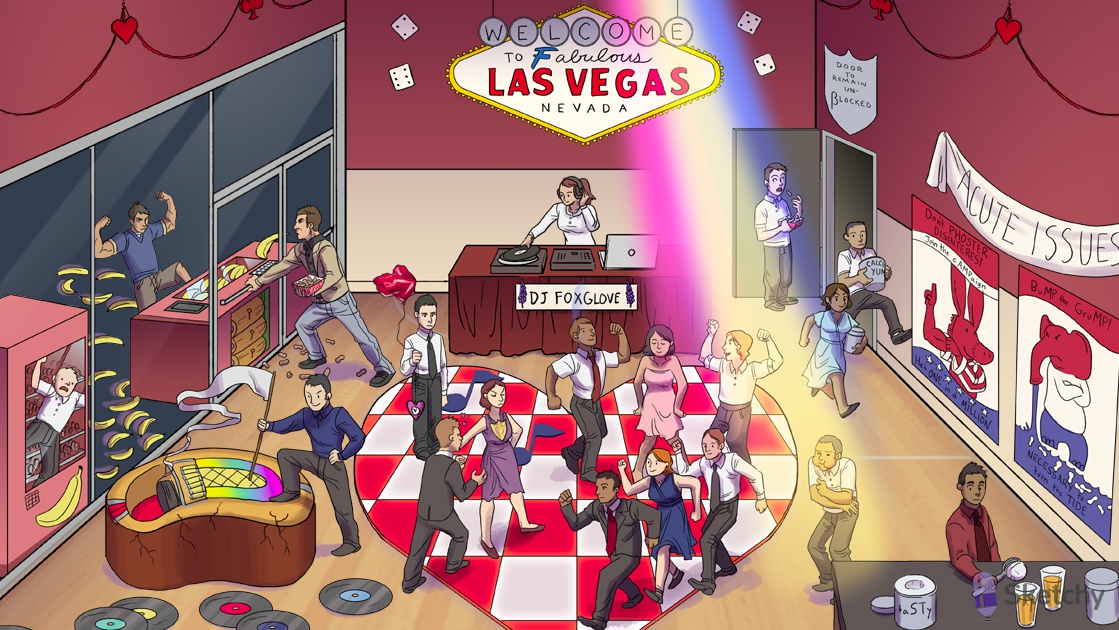
- DJ Foxglove: digoxin - derived from the foxglove plant. Only one approved for chronic HF
- Knocked over banana vending machine: inhibition of Na+/K+ ATPase
- Three P batteries: ATPase
- Obstructed salty sodium peanuts: increased intracellular sodium as a result of Na+/K+ ATPase inhibition
- Salty peanuts sneaking in the calci-yum icecream: increased intracellular sodium promotes calcium influx at the Na+/Ca2+ exchanger
- Flexed arm: increased cardiac contractility due to increased sarcoplasmic calcium stores

- Deflated heart balloon: symptomatic treatment of chronic systolic heart failure
- Las Vegas: direct stimulation of the vagus nerve allows treatment of certain arrhythmias. SA/AV, Atria more than V
- Rhythm-inducing record: antiarrhythmic

- Pile of bananas: side effect of hyperkalemia
- Various dances on the heart shaped dancefloor: digoxin may induce various arrhythmias
- TaSTy scoop: chronic digoxin use may cause "scooped" concave ST segments on ECG
- Dangling heart watch: side effect of bradycardia
- SA music note: side effect of bradycardia due to parasympathetic activity at SA node
- Heart shield: side effect heart block
- AV music note: side effect of heart block due to parasympathetic activity at AV node
- Gi side effects include nausea, vomiting, abdominal pain
- Yellow spotlight: side effect of xanthopsia (objects appear yellow)
- Remain unblocked: digoxin is contraindicated in heart block, CI with BB
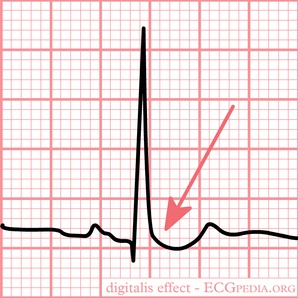

- Kid stuffed inside banana depleted vending machine: hypokalemia exacerbates digitalis toxicity, more binding with less K competing
- Long tapering decay flag on cracked kidney: renal insufficiency increases the serum half life of digoxin, increasing susceptibility to toxicity
- Records in kidney jukebox: many antiarrhythmics inhibit renal clearance of digoxin, increasing susceptibility to toxicity

- Fabulous: digoxin immune Fab reverses digoxin toxicity

- Acute issues: milrinone and nesiritide treat acute heart failure
- One in a million: milrinone
- Turn the tide: nesiritide

- One in a million: milrinone
- Don't phoster disinterest: milrinone inhibits phosphodiesterase
- CAMPaign: milrinone decreases breakdown of cAMP
- Flexing arm: milrinone increases cardiac contractility
- Dilated red donkey ears: milrinone causes arteriolar dilation and decreased afterload. Hypotension SE

- Turn the tide: nesiritide
- BuMP: nesiritide is a synthetic form of brain natriuretic peptide (BNP)
- GruMP: nesiritide increases cGMP in smooth muscle
- Dilated red ears and blue legs: nesiritide causes arteriolar and venous dilation, reducing afterload and preload
- Salty peanut stream: nesiritide causes natriuresis
ACE Inhibitors
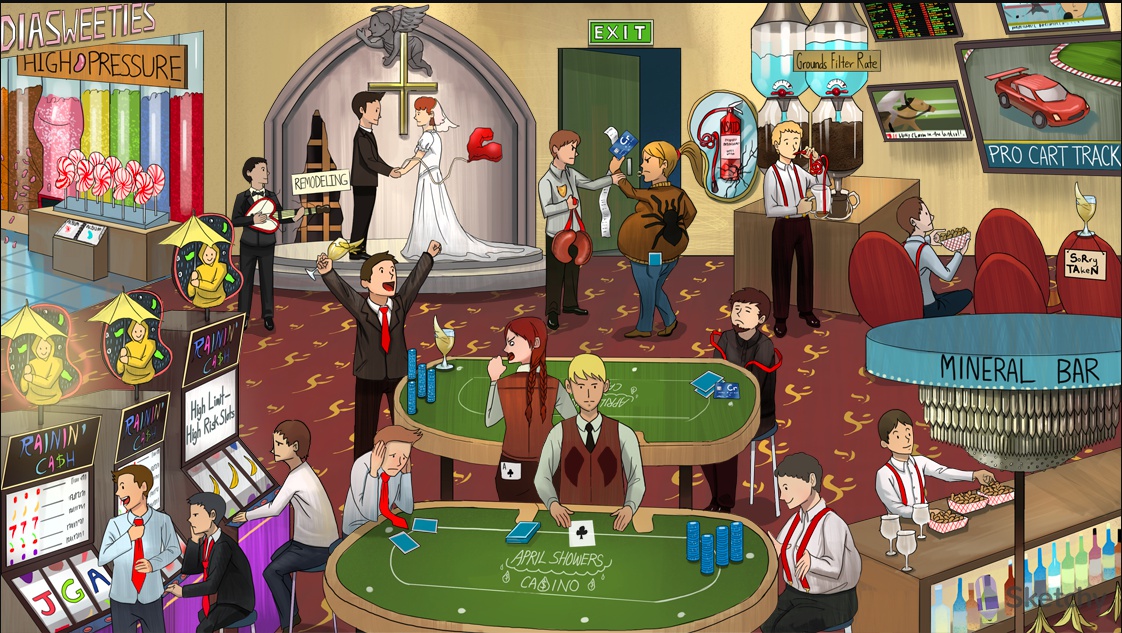
- Rain umbrella: renin
- The juxtaglomerular apparatus (JGA) is the site of synthesis, storage, and release of renin
- Loose red tie: angiotensinogen
- 1 Tense red tie: renin converts angiotensinogen into angiotensin I
- Lung vest and Ace card: ACE is located in the vascular endothelium of the lungs
- Two tense red suspenders with the winning ace: angiotensin II is converted from angiotensin I by ACE in the lungs

- Tense red suspenders: angiotensin II causes vasoconstriction
- Grounds filtration rate increased: angiotensin II increases GFR
- Pinched efferent end of straw: angiotensin II constricts the efferent arteriole
- Low volume glass coffee: Ang II important in low volume state in preserving GFR
- Pro Cart Track: proximal convoluted tubule
- Salty sodium peanuts at the Pro Cart Track: angiotensin II acts at the proximal convoluted tubule to increase sodium bicarb reabsorption
- Suspenders at Mineral Bar: angiotensin II increases aldosterone (a mineralocorticoid) release from the adrenal cortex
- Banana peels at the Mineral Bar: the mineralocorticoid aldosterone acts on the collecting duct to increase Na+ and fluid retention at the expense of K+, hypokalemia

- April: -pril suffix common to all ACE inhibitors
- Pocketed ace: ACE inhibitor
- Suspenders with the losing hand: ACE inhibitors prevent conversion of angiotensin I to angiotensin II
- Floppy red suspenders: ACE inhibitors counteract the pressor effects of angiotensin II
- ACE Inhibitors effects: decrease GFR, dilate efferent, decrease PCT Na/Bicarb absorption, decrease aldosterone secretion

- Credit card: ACE inhibitors can cause an expected bump in creatinine
- fainting: ACE inhibitors can cause significant hypotension and syncope in patients with high renin levels (e.g. heart failure)
- Raised banana daiquiri: ACE inhibitors can cause hyperkalemia due to decreased aldosterone levels
- Cheering single tense neck tie: ACE inhibitors increase levels of angiotensin 1 and renin
- Coughing dealer: ACE inhibitors can cause a dry cough
- Braids: ACE inhibitors can increase bradykinins causing lung irritation (avoid by using ARBs)

- Failing heart balloon: ACE inhibitors are first line agents in the treatment of chronic heart failure (reduce peripheral resistance, afterload, and blood volume, preload; less Ang II, less sympathetic activity on heart )
- Angel: ACE inhibitors reduce mortality in heart failure and MI
- ACE inhibitors decrease angiotensin II mediated cardiac remodeling
- Broken heart strings: ACE inhibitors are used in myocardial infarction (MI)
- High pressure pipes: ACE inhibitors are first line agents in the treatment of hypertension
- Kidney candy: ACE inhibitors slow the progression of diabetic nephropathy
- Album: diabetic patients with albuminuria and blood pressure greater than 130/80 are started on an ACE inhibitor

- "C" shaped ring on fat lip: ACE inhibitors are contraindicated in hereditary angioedema (due to C1 esterase deficiency) (face, lips, tongue)
- Tarantula: ACE inhibitors are teratogenic (fetal hypotension, renal failure, low urine)
- Fire extinguisher in cracked kidney glass: coadministration of ACE inhibitors with NSAIDs can precipitate acute kidney injury. NSAIDS decrease PGE responsible for dilation of afferent
- Constricted kidney purse straps: ACE inhibitors are contraindicated in bilateral renal artery stenosis (case: pt with longterm HTN and history of angina/MI)
- Credit card: ACE inhibitors can precipitate acute renal failure in bilateral renal artery stenosis as indicated by a persistent increase in creatinine

- SoRry TAkeN: -sartan suffix common to all angiotensin receptor blockers (ARBs)
- Raised banana daiquiri: ARBs can increase K+ retention causing hyperkalemia due to decreased aldosterone levels

- Losing at the high risk slots: aliskiren - a direct renin inhibitor
- Bananas: aliskiren can cause hyperkalemia due to decreased aldosterone levels
Diuretics
Acetazolamide, mannitol
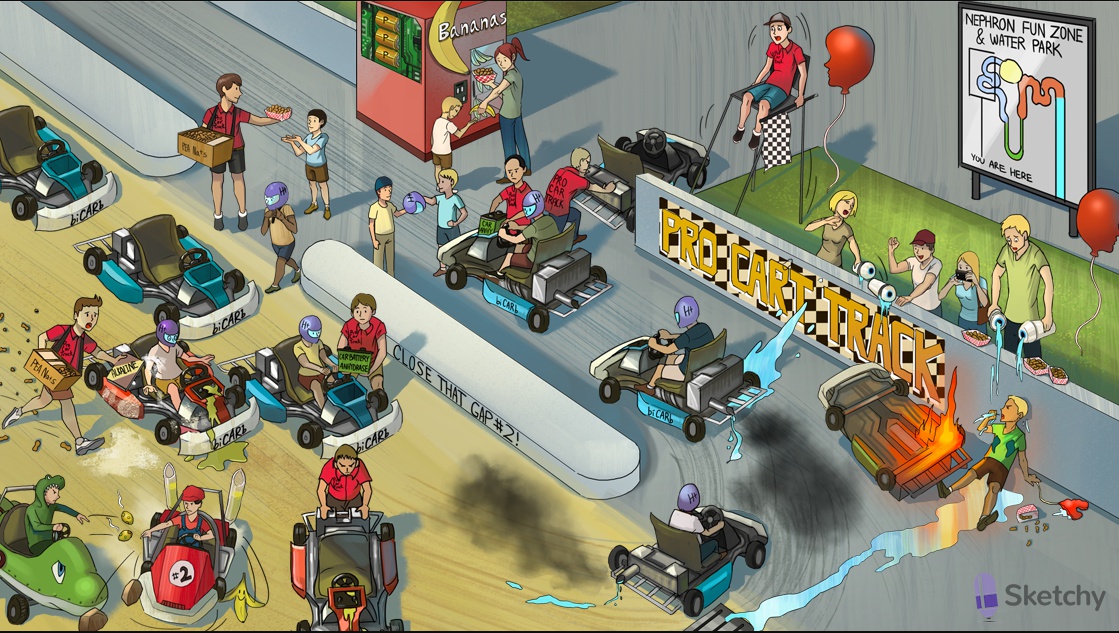
- Pro Cart Track: proximal convoluted tubule
- Yellow track: tubular lumen
- Gray track: intracellular compartment
- Banana vending machine: Na+/K+ ATPase on the basolateral membrane
- Mom take away peanuts, give banana: 3 Na out, 2 K in, low intracellular Na composition to make room for reabsorption later
- Three P batteries: ATPase
- Track worker distributing peanuts inside and letting H+ helmets out: Na+/H+ exchanger located on the apical membrane
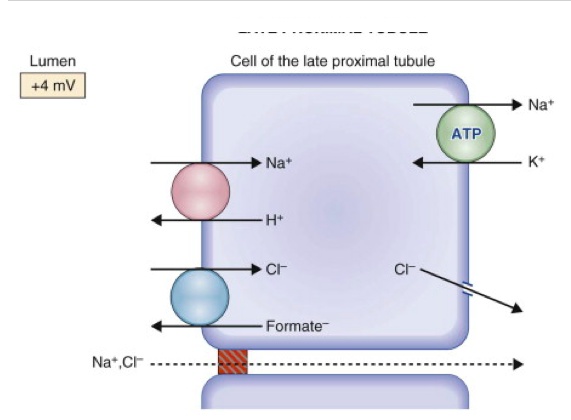

- biCARb race car: bicarb (HCO3-) in the lumen of the PCT
- Rider with H+ helmet sitting in biCARb: secreted H+ combines with bicarb in the tubular lumen to form carbonic acid (H2CO3)
- Car battery anhydrase on the inside track: luminal carbonic anhydrase (CA)
- Battery powered car producing H2O and CO2 exhaust: luminal CA converts carbonic acid (H2CO3) into H2O and CO2
- H2O and CO2 exhaust on the outside track: H2O and CO2 enters the intracellular space via diffusion
- Water sprayed over the wall: water is reabsorbed with solutes at the PCT (high permeability), osmolality maintained
- Car battery anhydrase on the outside track: intracellular CA converts H2O and CO2 back into carbonic acid (H2CO3)
- H+ helmet leaving the biCARb: Intracellular carbonic acid (H2CO3) dissociates back into H+ and bicarb (HCO3-)
- Recycled H+ helmet: H+ transported back into the lumen by the Na+/H+ exchanger
- biCARb taken away: intracellular bicarb is absorbed via a basolateral transporter
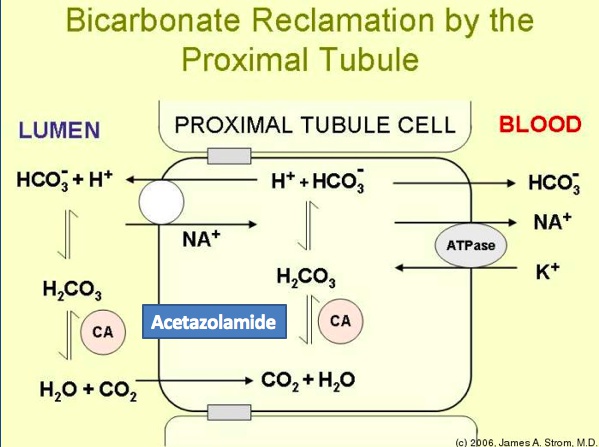
Acetazolamide

- Battery acid breaking car battery: acetazolamide inhibits carbonic anhydrase (preventing reabsorption of bicarb)
- Proximal convoluted tubule (site of action of acetazolamide and mannitol)
- Spilled alkaline substance on inside track: CA inhibitors (e.g. acetazolamide) cause bicarb to stay in the tubular lumen leading to urine alkalinization
- Dropping salty peanuts on the inside track: CA inhibitors prevent the reabsorption of sodium (with bicarb) causing natriuresis
- "Close that gap!": CA inhibitors (e.g. acetazolamide) cause a normal anion gap metabolic acidosis (increased Cl production )

- leaves enhanced Na absorption by later nephron, efficacy decreases chronically
- Spilled eyeball cups: CA inhibitors (e.g. acetazolamide) decreased production of aqueous humor (useful in the management of glaucoma)
- High pressure head balloon: CA inhibitors (e.g. acetazolamide) decreased production of CSF (useful in the management of idiopathic intracranial hypertension) (pseudotumor cerebri)
- High altitude: CA inhibitors (e.g. acetazolamide) are useful in the treatment and prevention of mountain sickness (weakness, dizziness, nausea, pulmonary/cerebral edema)
- increased pH leads to increased solubility of uric acid and cysteine, prevent stone formation and gout formation

- Banana peel: CA inhibitors (e.g. acetazolamide) can cause hypokalemia (potassium wasting) (reabsorption of Na at CD)
- biCARb taken away: CA inhibitors cause excretion of bicarb
- Two tubes of acid: CA inhibitors cause a type 2 renal tubular acidosis (defect in proximal bicarb reabsorption)
- Rocks on the inside track: CA inhibitors promote the formation of calcium phosphate stones (insoluble at high pH)
- Rotten sulfur eggs: CA inhibitors (e.g. acetazolamide) are sulfa drugs, allergy
Mannitol

- Tall man: mannitol (an osmotic diuretic) acts at the PCT and descending limb of the loop of Henle. Non absorbable, promoting diuresis
- High pressure head balloon: mannitol draws free water out of the CNS (useful in the treatment of elevated intracranial pressure)
- Spilled eyeball cups: mannitol draws free water out of the eye (decreases intraocular pressure)

- Tall man causing wet lungs: mannitol induced expanded extracellular volume can cause pulmonary edema
- Spilled salty peanuts: mannitol induced expanded extracellular volume can cause hyponatremia
- Tall man dousing failing heart balloon: mannitol induced expanded extracellular volume can exacerbate heart failure
- Elevated salty peanuts: excessive mannitol induced water depletion can cause hypernatremia
Loop Diuretics
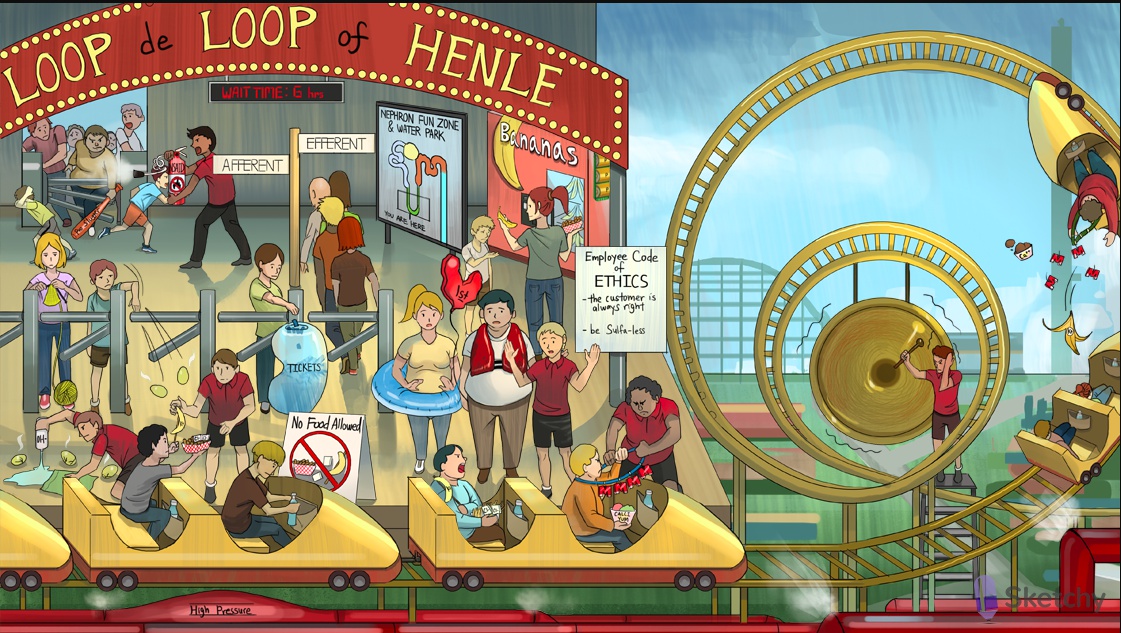
- Loop de loop of Henle: loop of Henle
- Yellow track: tubular lumen
- Platform: intracellular compartment
- Backwall: interstitium
- Na/Cl actively reabsorbed
- Banana vending machine: Na+/K+ ATPase on the basolateral membrane
- Three P batteries: ATPase
- Track worker taking peanuts, bananas, and 2 chloride packets: Na+/K+/2Cl- cotransporter (NKCC) reabsorbs these ions at the luminal membrane of the TAL
- Water secured in car: the TAL is impermeable to water ("diluting segment")


- Thick ascending limb (TAL) of the loop of Henle (site of action of loop diuretics)]
- Furious kid: furosemide (a loop diuretic)
- Furious kid clinging to food: furosemide blocks the NKCC on the luminal membrane of the TAL
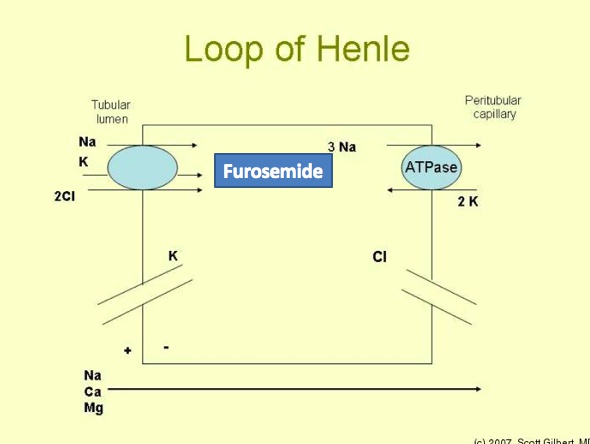

- Ethics: ethacrynic acid (a loop diuretic)
- Sulfa-less ethics: ethacrynic acid is not a sulfa drug

- Pro-slugger: prostaglandins
- Furious kid wielding pro-slugger: loop diuretics induce the expression of COX-2, synthesizing prostaglandins that enhance salt excretion and dilate the afferent arteriole. More blood flow = more diuresis. Enhancing loop diuretics
- Fire extinguisher inhibiting the pro-slugger: NSAIDs decrease prostaglandin synthesis, interfering with the actions of loop diuretics

- Failing heart balloon: loop diuretics are 1st line for the symptomatic treatment of acute decompensated heart failure with fluid overload
- Wet lungs: loop diuretics treat symptoms of pulmonary edema in an acute heart failure exacerbation
- Yellow inner tube: loop diuretics treat ascites in liver failure
- High pressure pipes: loop diuretics can be useful in the treatment of hypertension

- Furious kid clinging to magnets and calci-yum icecream: by blocking the NKCC, loop diuretics reduce the lumen positive potential, promoting the excretion of Mg2+ and Ca2+ (K usually diffuses out to create positive potential)
- Falling magnets: loop diuretics can cause hypomagnesemia
- Falling calci-yum icecream: loop diuretics can cause hypocalcemia (rare)
- Banana peel: loop diuretics can cause hypokalemia (potassium wasting)
- Contracted bleach OH bottle: loop diuretics can cause contraction alkalosis. Increased renin, increased aldosterone, more K excretion, increased Ang II (Na absorption at PCT, H secretion)


- Loud gong: loop diuretics can be ototoxic
- Stinky sulfur eggs: most loop diuretics (e.g. furosemide) are sulfa drugs
- Kidney filled with blue tickets: loop diuretics can cause interstitial nephritis (blue cells on histology )
- Knitting needles: loop diuretics can cause hyperuricemia, needle shaped crystals. Uric acid reabsorption in PCT enhanced in hypovolemia
- Contracted bleach OH bottle: loop diuretics can cause contraction alkalosis. Increased renin, increased aldosterone, more K excretion, increased Ang II (Na absorption at PCT, H secretion)
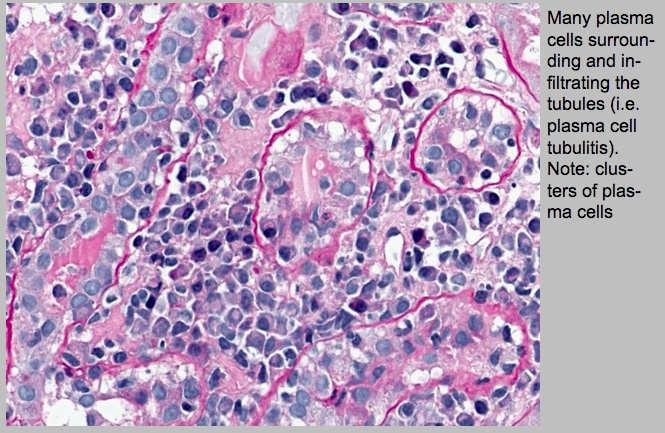
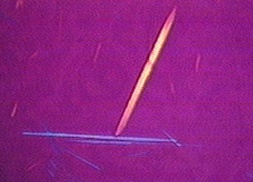
Thiazides

- Distal convoluted tube slide: distal convoluted tubule (DCT)
- Yellow tube slide: tubular lumen
- Area outside slide: intracellular compartment
- Banana vending machine: Na+/K+ ATPase on the basolateral membrane
- Three P batteries: ATPase
- impermeable to water, make urine even more dilute
- Sodium chloride salt scraper: NaCl cotransporter reabsorbs these ions at the apical membrane of the DCT
- Active slider dropping calci-yum icecream: calcium is actively reabsorbed at the DCT (regulated by PTH)
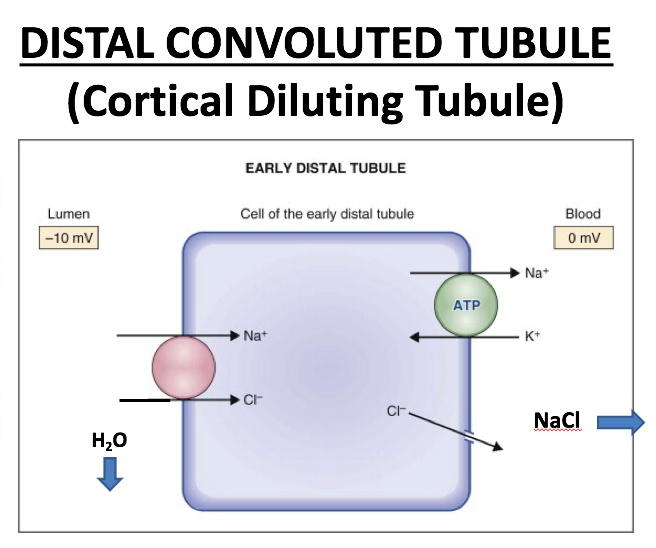

- pale Chloro-thighs: hydrochlorothiazide and chlorthalidone (thiazide diuretics, longer duration)
- Distal convoluted tubule (site of action of thiazide diuretics)
- Sodium chloride dumping into pool: thiazide diuretics inhibit NaCl reabsorption by blocking the NaCl cotransporter on the apical membrane (causing natriuresis)
- Chloro-thighs kid dropping calci-yum: thiazide diuretics enhance calcium reabsorption (PCT water depletion = more absorption)
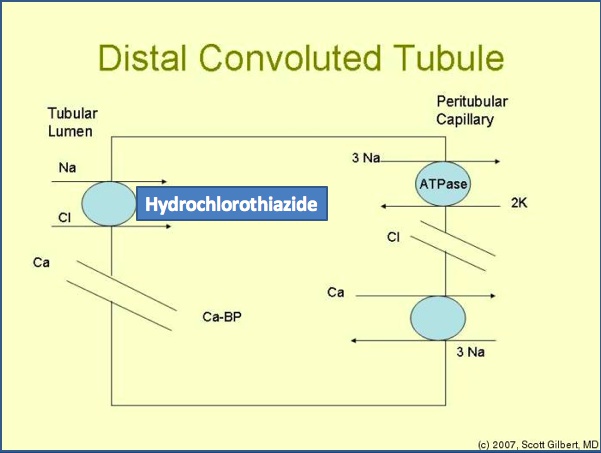

- High pressure pipes: thiazide diuretics are one of the first line treatments for mild or moderate hypertension
- Failing heart balloon: thiazide diuretics can be useful in the symptomatic treatment of heart failure (loop diuretics are first line)
- Insipidus fountain: thiazide diuretics treat nephrogenic diabetes insipidus. Reduced volume induce PCT reabsorption of Na and water, less reliance on CD
- Removing tube slide stones: thiazide diuretics can be used to prevent calcium stones (increased calcium reabsorption causes hypocalciuria)
- New calcium chalk: thiazide diuretics may benefit patients with osteoporosis (due to increased calcium reabsorption)

- Elevated calci-yum ice cream: thiazide diuretics can cause hypercalcemia
- Banana peel: thiazide diuretics can cause hypokalemia (potassium wasting)
- Contracted bleach bottle: thiazides can cause contraction alkalosis
- Elevated stick of butter: thiazide diuretics can cause hyperlipidemia, increase serum cholesterol/LDL
- Elevated candy jar: thiazide diuretics can cause hyperglycemia, less insulin secretion and glucose utilization
- Yellow knitting needles: thiazide diuretics can cause hyperuricemia (can precipitate gout). Hypovolemia associated uric acid absorption
- "Lift"ium balloons: thiazide diuretics can cause increased lithium levels (bipolar disorder treatment)
- Spilled peanut shells: thiazide diuretics can cause hyponatremia
- Rotten sulfur eggs: thiazide diuretics are sulfa drugs
K sparing
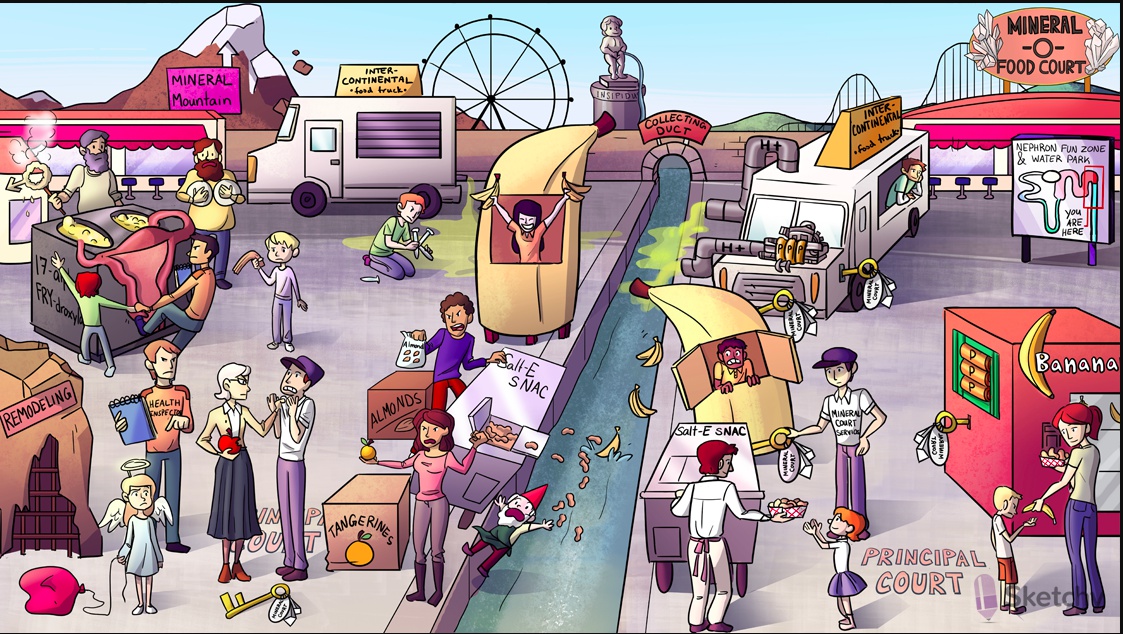
- Central gutter: collecting duct
- Food court ground: intracellular compartment
- Water in gutter: tubular lumen
- Collecting duct (site of action of the K+ sparing diuretics)
- Principal court: principal cell of the collecting duct (major site of Na+, K+, and water transport)
- Banana vending machine: Na+/K+ ATPase on the basolateral membrane
- Three P batteries: ATPase
- Salt-E sNaC cart: epithelial Na+ channels (ENaC) reabsorb Na+ across the luminal membrane of the collecting duct
- Banana stand dumping bananas: : K+ channels allow the excretion of K+ across the luminal membrane of the collecting duct
- Salt-E sNaC cart toppling banana stand: reabsorption of Na+ creates a negative luminal potential that facilitates K+ excretion
- a intercontinental: a intercalated cell of the collecting duct (major site of H+ secretion)
- Battery powered acid pump: H+ATPase on the apical membrane of the a intercalated pumps H+ into the lumen
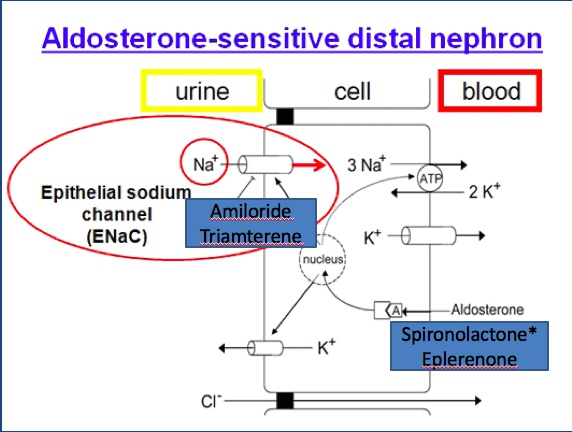


- Mineral - O - Food Court: mineralocorticoids (i.e. aldosterone) exert their effects at the collecting duct
- Mineral key: aldosterone (a mineralocorticoid)
- Mineral court services: intracellular mineralocorticoid (i.e. aldosterone) receptor
- Mineral key activating the Salt-E sNaC cart: aldosterone upregulates ENaCs on the apical membrane, increasing Na+ reabsorption
- Mineral key activating the banana stand: aldosterone upregulates K+ channels on the apical membrane, increasing K+ excretion
- Mineral key activating the banana vending machine: aldosterone upregulates Na+/K+ ATPase on the basolateral membrane
- Mineral key activating the acid pump: aldosterone upregulates H+ATPase on the apical membrane, increasing H+ excretion

- Almonds: amiloride (a K+ sparing diuretic)
- Almonds blocking the Salt-E sNaC cart: amiloride inhibits Na+ reabsorption through ENaC
- Salty sodium peanuts falling into duct: K+ sparing diuretics inhibit Na+ reabsorption at the collecting duct, promoting natriuresis. Increased positive ion spared K excretion


- Tangerines: triamterene (a K+ sparing diuretic)
- Tangerines blocking the Salt-E sNaC cart: triamterene inhibits Na+ reabsorption through ENaC
- Salty sodium peanuts falling into duct: K+ sparing diuretics inhibit Na+ reabsorption at the collecting duct, promoting natriuresis. Increased positive ion spared K excretion


- Apple: eplerenone (a K+ sparing diuretic)
- Teacher with apple antagonizing the mineral court services man: eplerenone antagonizes the mineralocorticoid receptor


- Crumbling mineral mountain: K+ diuretics (e.g. spironolactone, eplerenone) are useful in the treatment of 1 and 2 hyperaldosteronism (high BP, low K, metabolic alkalosis)
- Failing heart balloon: K+ diuretics (e.g. spironolactone, eplerenone) are useful in the treatment of heart failure
- Remodeling: mineralocorticoid antagonists (e.g. spironolactone, eplerenone) prevent myocardial remodeling induced by high levels of aldosterone
- Angel: mineralocorticoid antagonists (e.g. spironolactone, eplerenone) decrease mortality in heart failure
- insipidus fountain: amiloride is useful in the treatment of Li+ induced nephrogenic diabetes insipidus, block Li reabsorption
- Little gnome blocked by almonds and tangerines: amiloride and triamterene are useful in the treatment of Liddle's syndrome (overactive ENaCs)

- Elevated bananas: K+ sparing diuretics can cause hyperkalemia
- Acid spill into intracellular space: K+ sparing diuretics cause a normal anion gap metabolic acidosis (by decreasing the function of the H+ATPase)
- 4 acid tubes: K+ sparing diuretics inhibit the effects of aldosterone in the collecting duct causing a type 4 renal tubular acidosis (RTA)
- Big K: type 4 RTA is associated with hyperkalemia

- Spiral-bound notebook: spironolactone (a K+ sparing diuretic)
- Health inspector antagonizing the mineral court services man: spironolactone antagonizes the mineralocorticoid receptor
- Fried male symbol: testosterone produced from cholesterol
- Health inspector inhibiting 17-a-"fry"droxylase: spironolactone inhibits 17a-hydroxylase (an enzyme in the testosterone synthesis pathway)


- Bubbling ovary shaped vats: spironolactone treats the symptoms of androgen excess in polycystic ovarian syndrome (PCOS)
- Bushy beard: symptoms of androgen excess (e.g. hirsutism) in PCOS (treat with spironolactone)
- Preventing boy from receiving onion ring: spironolactone directly antagonizes the androgen receptor
- Lids on chest: spironolactone can cause gynecomastia
- Droopy churro: spironolactone can cause impotence and decreased libido
Antihypertensive
CCB
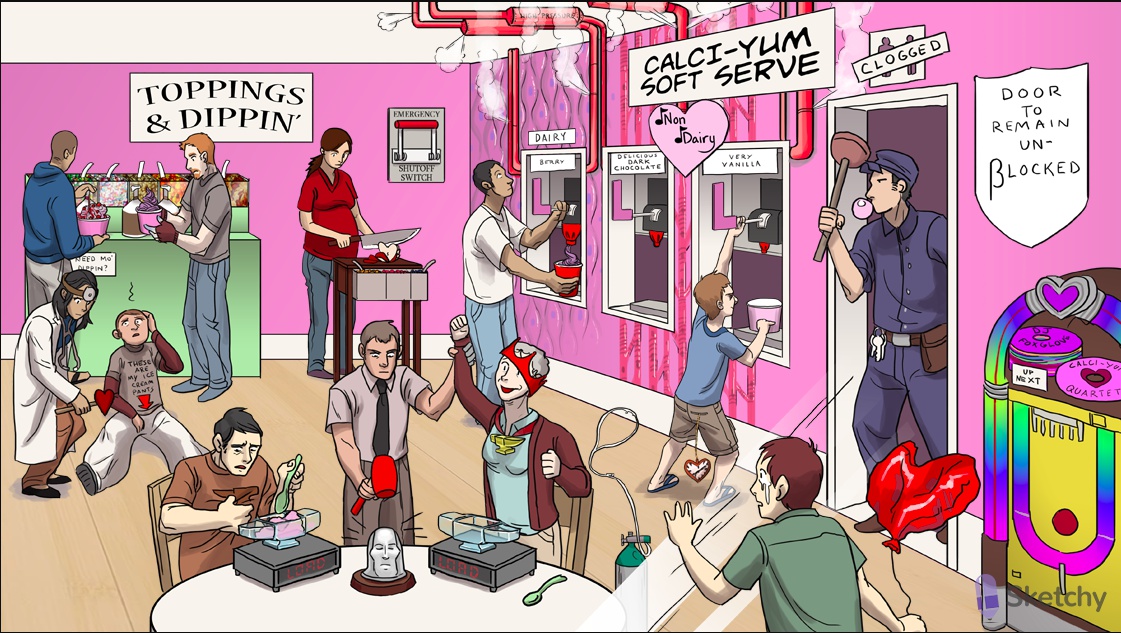
- Calci yum: CCB
- L-shaped handle: calcium channel blockers target voltage gated L-type calcium channels
- Dairy: dihydropyridines
- Non-dairy: nondihydropyridines
- Smooth muscle tile: dihydropyridines block L-type calcium channels in smooth muscle
- Cardiac muscle tile: non-dihydropyridines block L-type calcium channels in cardiac muscle

- Dippin' station: -dipine suffix of dihydropyridines (e.g. nifedipine, amlodipine, nicardipine)

- Dilated dairy nozzle: dihydropyridines cause vasodilation
- Dilated coronary crown: dihydropyridines (e.g. amlodipine, felodipine) dilate coronary arteries
- Reduced load: dihydropyridines reduce afterload

- Very vanilla: verapamil (a non-dihydropyridine)
- Delicious dark chocolate: diltiazem (a non-dihydropyridine)

- Medium sized nozzle: diltiazem has some vasodilatory activity
- Weak kid at the non-dairy: non-dihydropyridines decrease cardiac contractility
- Music notes: non-dihydropyridines decrease activity at the SA and AV nodes
- Low dangling heart watch: inhibition of the SA node by non-dihydropyridines causes bradycardia
- Discarded oxygen: non-dihydropyridines decrease myocardial oxygen demand

- Emergency shut off: an IV dihydropyridine (e.g. clevidipine, nicardipine) can treat hypertensive emergency
- Large knife: nifedipine (a dihydropyridine)
- Pregnant knife lady: nifedipine is used to treat hypertension in pregnancy
- "Blue fingertips: dihydropyridines treat Raynaud's syndrome"
- Brain ice cream with berries: berry aneurysm (PCOS)
- Strawberry syrup: subarachnoid hemorrhage
- Need mo' dippin' with berry brain ice cream: nimodipine prevents vasospasm after a subarachnoid hemorrhage
CCB:
- High pressure pipes: both CCBs treat hypertension
- Angina anvil: CCBs treat stable angina
- Anvil medal: CCBs treat Prinzmetal angina

- Pounding head bell: migraine prophylaxis with verapamil
- Jukebox: non-dihydropyridines have antiarrhythmic properties
CCB:
- High pressure pipes: both CCBs treat hypertension
- Angina anvil: CCBs treat stable angina
- Anvil medal: CCBs treat Prinzmetal angina

- Lightheaded patron: dihydropyridines can cause lightheadedness and headache
- Baggy pants: dihydropyridines can cause peripheral edema (dilation of pre capillary vessels, arterioles, increase hydrostatic pressure)
- Heart reflex hammer: dihydropyridines can cause reflex tachycardia
- Knife cutting heart: nifedipine can exacerbate myocardial ischemia due to reflex tachycardia - avoid in patients with unstable angina or MI (shorter acting, higher SE)

- Clogged toilet: verapamil can cause constipation
- Expanding gum: verapamil can cause gingival hypertrophy
- Remain un-blocked: verapamil and diltiazem are relatively contraindicated in patients with heart block
- Verapamil or diltiazem combined with a beta blocker may produce excessive AV block
- Failing heart balloon locked out of store: CCBs can worsen heart failure (increased sympathetic activity and decreased contractility)
Antihypertensives
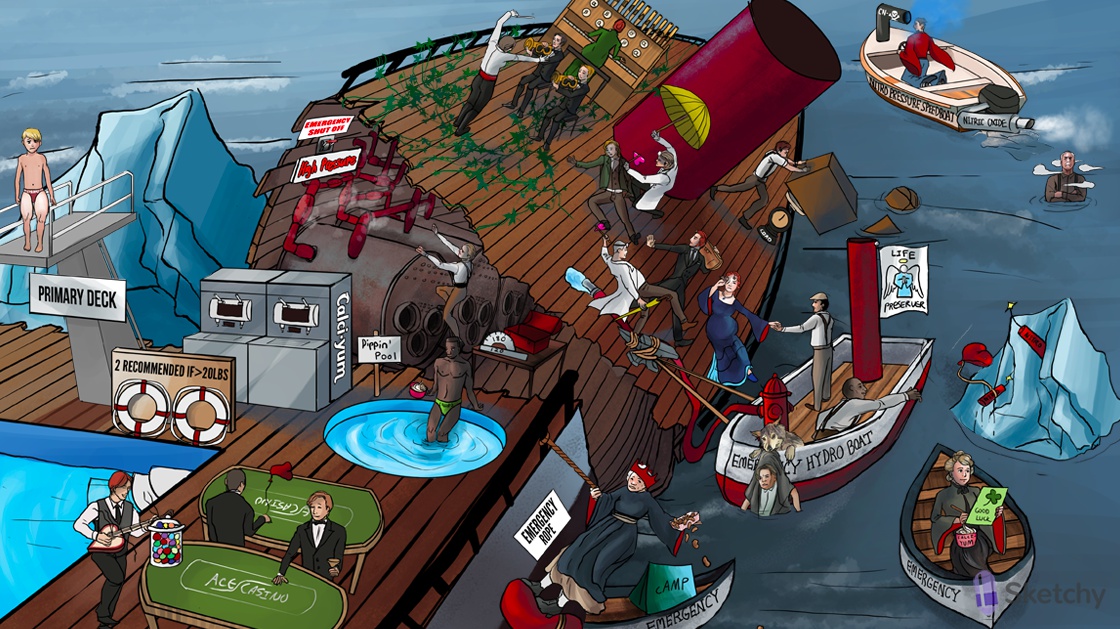
- High tension, high sea: anti hypertensives
- High pressure pipes: antihypertensives
- Primary deck: primary (essential) hypertension treatment
- Chloro-thighs: hydrochlorothiazide is a first line agent for treating primary HTN
- Dippin' pool: long acting dihydropyridines (-dipine suffix) treat primary hypertension
- Ace-stealing dealer: ACE inhibitors treat primary HTN

- Two life preservers if > 20 lbs: two antihypertensives for BP > 20/10 mmHg above goal
- Elderly black man with calci-YUM icecream: black and elderly patients respond well to a CCB for treatment of primary HTN
- Chloro-thighs: black and elderly patients respond well to hydrochlorothiazide for treatment of primary HTN
- ACE inhibitors are first line treatment for hypertension in patients with heart failure (failing heart balloon), MI (broken heart strings), and diabetes (candy jar)

- Emergency shut-off switch: treatment for hypertensive emergency
- 180 degree protractor over 12 inch ruler: hypertensive emergency (SBP >180 or DBP >120)
- Hole in the Titanic: hypertensive emergency is defined by end-organ damage plus elevated BP (SBP >180 or DBP >120)
- Reduce pressure gradually. Reducing too quickly can lead to ischemia

- Muted beta bugles: beta-1 antagonists (e.g. esmolol and metoprolol) can be used for hypertensive emergency
- Ivy: IV beta blocker administration treats hypertensive emergency
- Alpha and beta organ stops: labetalol (alpha and beta antagonist) can be used in hypertensive emergency
- Calci-yum ice cream: IV calcium channel blockers (e.g. nicardipine, clevidipine) can be used in hypertensive emergency
- Nice card: nicardipine (a dihydropyridine CCB)
- Clover: clevidipine (a dihydropyridine CCB)
- Hydro-boat: hydralazine treats hypertensive emergency
- Nitro-pressure speedboat: nitroprusside can be used to in hypertensive emergency
- Old lady Pam: fenoldopam treats hypertensive emergency

- Dilated red sleeves: dihydropyridine CCBs (e.g. nicardipine and clevidipine) cause arteriolar dilation
- Dilated red smokestack: many agents used in hypertensive emergencies are potent vasodilartors
- Unloaded scale: vasodilation reduces afterload
- Heart-shaped reflex hammer and rain umbrella: hypotension leads to reflex tachycardia and increased renin levels

- Hydro-boat: hydralazine treats hypertensive emergency
- Dilated red hose: hydralazine is a direct arteriolar vasodilator
- Pregnant woman boarding hydro-boat: hydralazine is safe in pregnancy
- Fainting: hydralazine can cause hypotension
- Anvil anchoring hydro boat: hydralazine induced reflex tachycardia can worsen angina
- Lupus wolf: hydralazine can cause drug-induced lupus
- Beta-1 bugler leaving to get on hydro boat: administer beta-blocker with hydralazine to prevent reflex tachycardia
- Muted beta-1 bugler deflecting reflex hammer and rain umbrella: beta blockers minimize the reflexive sympathetic activation

- Dynamite: nitrate (e.g. nitroglycerine)
- Failing heart balloon: hydralazine combined with a nitrate (e.g. nitroglycerine) treats heart failure (hydralazine arteriodilation, nitrate venodilation)
- Guardian angel: hydralazine combined with a nitrate (e.g. nitroglycerine) provides a mortality benefit for certain patients in heart failure

- Nitro-pressure speedboat: nitroprusside can be used to in hypertensive emergency
- Grump: nitric oxide promotes smooth muscle relaxation by increasing cyclic GMP
- Nitric oxide exhaust: nitroprusside causes vasodilation via nitric oxide
- Sailor with dilated red sleeves and blue pants: nitroprusside causes arteriolar and venous dilation
- Blue cyanide exhaust: cyanide poisoning is a side effect of nitroprusside, altered mental status, seizures

- Old lady Pam: fenoldopam treats hypertensive emergency
- Single rope: fenoldopam is a selective dopamine 1 receptor agonist
- Camping tent: fenoldopam (a D1 agonist) increases cAMP, arterial dilation (renal, mesenteric, coronary)
- DIlated red sleeves: fenoldopam causes arterial dilation
- Dilated red crown: fenoldopam causes coronary vasodilation
- Rope connected to kidney: fenoldopam dilates renal arteries, increasing renal perfusion
- Salty peanuts falling into water: Fenoldopam (a D1 agonist) causes natriuresis, Na/water excretion
Antiarrythmics
- Class I and III: rhythm control
- Class II and IV: rate control
Class I
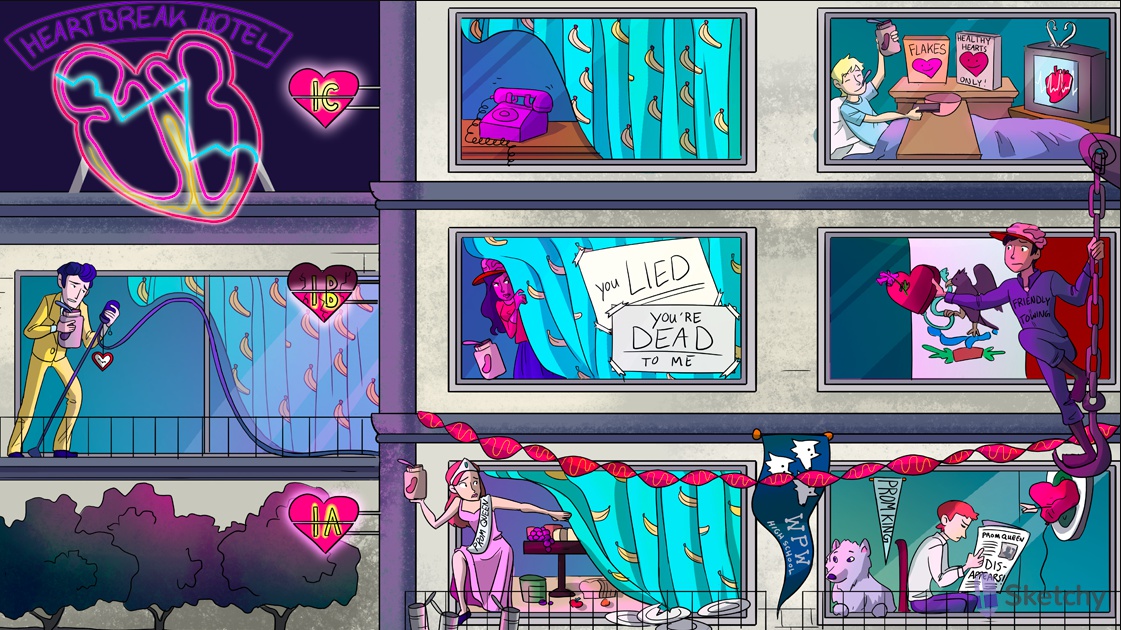
- Microphone: Phase 0: upstroke dictated by Na+
- Wire: Phase 2: plateau dictated by Ca2+
- Wire: Phase 3: repolarization dictated by K+
- Potassium banana curtain: K+ current present during phase 2 (plateau) and phase 3 (repolarization) of the cardiac action potential

- Soloist: class I antiarrhythmics
- Soloist holding peanut butter jar: class I antiarrhythmics block sodium channels (phase 0)
- Soloist tipping mic stand: class I antiarrhythmics decrease the slope of the phase 0 upstroke (slows conduction of the cardiac AP)
- Illuminated atria, ventricles, and His-Purkinje system: class I antiarrhythmics affect the Na+ dependent cardiac action potential (no action at the SA and AV nodes, upstroke by Ca channels)
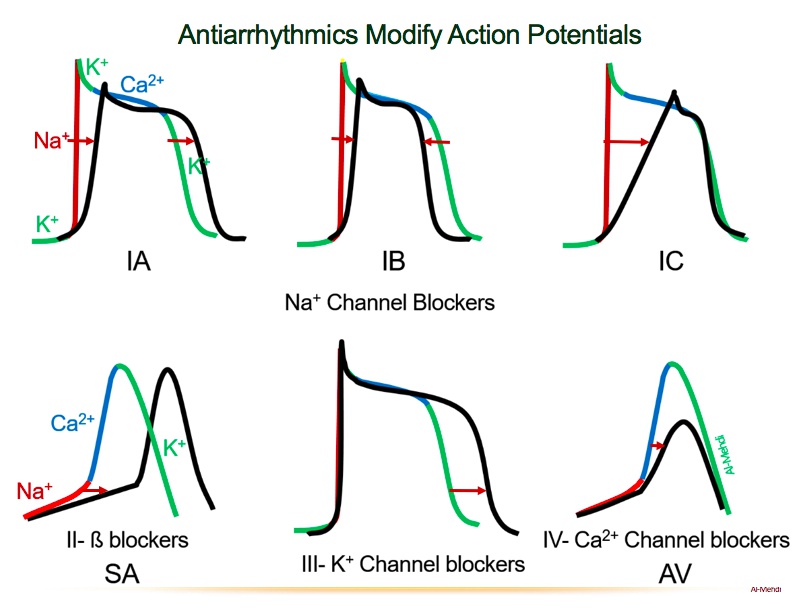

- Inactivating spoon in open peanut butter jar: class I antiarrhythmics bind to open or inactivated Na+ channels, poorly to channels in resting state. Cells depolarizing are in open states. Channels are in inactivated states during refractory period
- Heart watch tipping mic stand: "use dependance"- class I antiarrhythmics have a greater effect on rapidly depolarizing tissues (increased heart rate causes slower phase 0 upstroke) (great for tachycardias and minimally affect normal cells)


- Wide QRS shaped crack: class I antiarrhythmics widen the QRS complex on the ECG (decreased AP conduction velocity) (faster cells bind more and slow down more) (QRS widen as HR increases)
Ia

- Class IA antiarrhythmics: quinidine, procainamide, disopyramide
- Dining prom queen: quinidine (class IA antiarrhythmic)
- Prom king: procainamide (class IA antiarrhythmic)
- "Disappears!": disopyramide (class IA antiarrhythmic)

- Lightly held peanut butter jar: class IA antiarrhythmics have an intermediate binding affinity for the Na+ channel (intermediate use-dependence, moderate slowing of the phase 0 upstroke)
- Pushing away the curtain: class IA antiarrhythmics also block K+ channels, prolonging phase 2 and 3 of the cardiac action potential -> prolonged refractory period

- Illuminated top and bottom of heart: class IA antiarrhythmics treat supraventricular and ventricular arrhythmias
- White wolf pack: class IA antiarrhythmics treat Wolff-Parkinson-White (WPW) syndrome (a type of SVT) (extra pathway stopped)

- Tin cans: quinidine toxicity can cause cinchonism (a syndrome of tinnitus, headache,dizziness)
- Broken plates: quinidine can cause thrombocytopenia
- Prom king's lupus wolf: procainamide can cause a lupus-like syndrome
- Darts deflating failing heart balloon: disopyramide can exacerbate heart failure (negative inotropy)
- Twisted torsades streamer: class IA antiarrhythmics can cause Q-T interval prolongation (precipitates torsades) (K channel prolongation)
Ib

- Class IB antiarrhythmics: lidocaine, mexiletine, phenytoin
- "LIED": lidocaine (class IB antiarrhythmic)
- Friendly Towing: phenytoin (an anti-epileptic) shows some class IB antiarrhythmic properties
- Mexican flag: mexiletine (class IB antiarrhythmic)

- Dropped peanut butter jar: class IB antiarrhythmics have an low binding affinity for the Na+ channel (low use-dependence, modest slowing of the phase 0 upstroke)
- Pulling in the curtain: class IB antiarrhythmics shorten phase 2 and 3 of the cardiac action potential -> shortened refractory period

- Illuminated, cracked bottom of heart: class IB antiarrhythmics treat ventricular arrhythmias (especially in ischemic tissue) (rapid binding and unbinding selects for tissues with Na in open/inactive states. Ventricles/HIS has longer AP compared to atrium)
- "DEAD": class IB antiarrhythmics treat ischemia induced ventricular arrhythmias (dead tissues have reduced AP with delayed Na channel transition from inactivated to resting)

- Brain trucker hat: class IB antiarrhythmics cause neurological side effects (e.g.paresthesias, tremor, convulsions)
Ic

- Class IC antiarrhythmics: propafenone, flecainide
- Flakes: flecainide (class IC antiarrhythmic)
- purple phone: propafenone (class IC antiarrhythmic)

- Tightly held peanut butter jar: class IC antiarrhythmics have an strong binding affinity for the Na+ channel (strong use-dependence, drastic slowing of the phase 0 upstroke)
- Untouched potassium curtain: class IC antiarrhythmics do not affect the cardiac action potential duration

- Illuminated top and bottom of heart: class IC antiarrhythmics treat supraventricular and ventricular arrhythmias
- Irregularly irregular signal: class IC antiarrhythmics treat atrial fibrillation (and flutter)
- Converting the signal: class IC antiarrhythmics can restore and maintain normal sinus rhythm in atrial fibrillation and flutter

- "Healthy hearts only!": class IC antiarrhythmics are contraindicated in patients with history of structural or ischemic heart disease (proarrhythmic effects) (can cause delayed in conduction speed out of proportion to prolongation of refractory period)
Class II
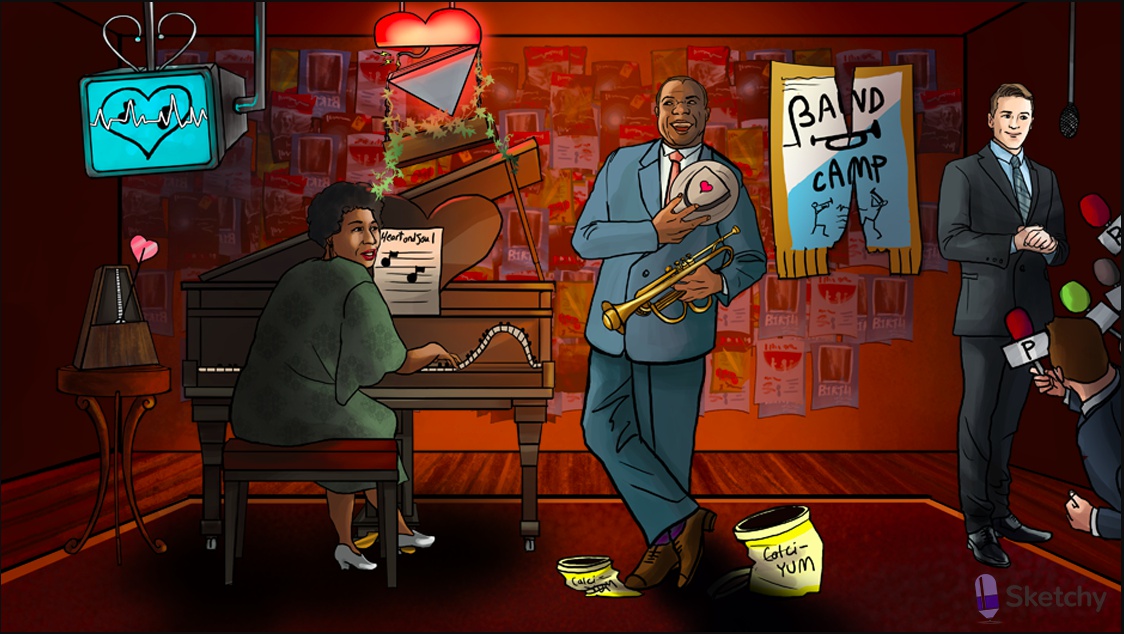
- Phase 4: pacemaker current dictated by Na+ and other ions
- Phase 0: upstroke dictated by Ca2+
- Phase 3: repolarization dictated by K+
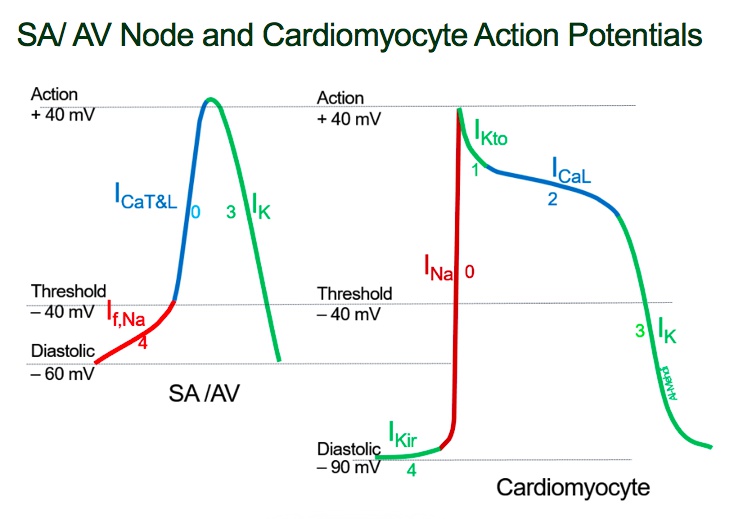

- Duet: Class 2 antiarrhythmics
- Muted beta bugle: beta blockers (class 2 antiarrhythmics)
- notes: beta blockers treat arrhythmias by blocking sympathetic input to the SA and AV nodes
- Torn band camp: beta blockers decrease cAMP
- Crushed calci-YUM ice cream cartons: decreased cAMP leads to closure of membrane calcium channels
- Sliding up the keys: beta blockers prolong phase 4 of the nodal action potential -> decreased pacemaker activity, prolonged conduction time and refractory period.
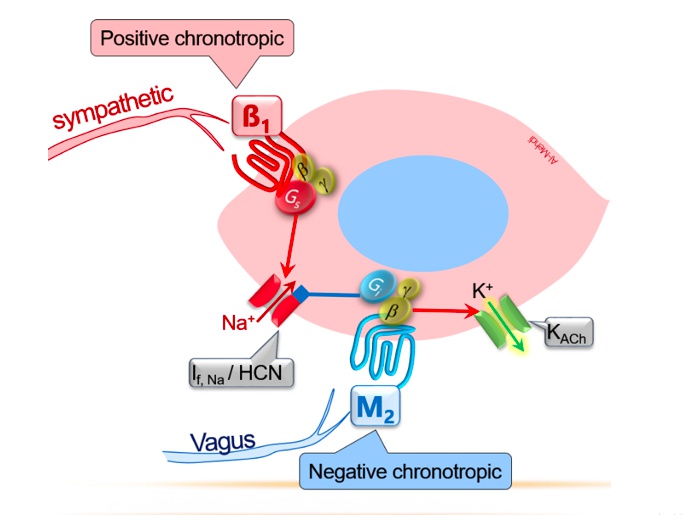


- Disconnected bottom: beta blockers decrease atrioventricular conduction (AV block)
- Lit up top: beta blockers treat supraventricular arrhythmias (e.g. atrial fibrillation with RVR)
- Ivy: IV beta blockers (e.g. esmolol) can be used for acute supraventricular arrhythmias
- Irregularly irregular static: beta blockers are useful in atrial fibrillation and flutter
- Metronome: beta blockers prevent rapid ventricular response in atrial fibrillation and flutter ("rate control") (increase AV node refractory period, slow ventricular response rate)

- Hat shielding heart: beta blockers can cause heart block
- Public Relations: heart block manifests as a prolonged PR interval on ECG
Class III
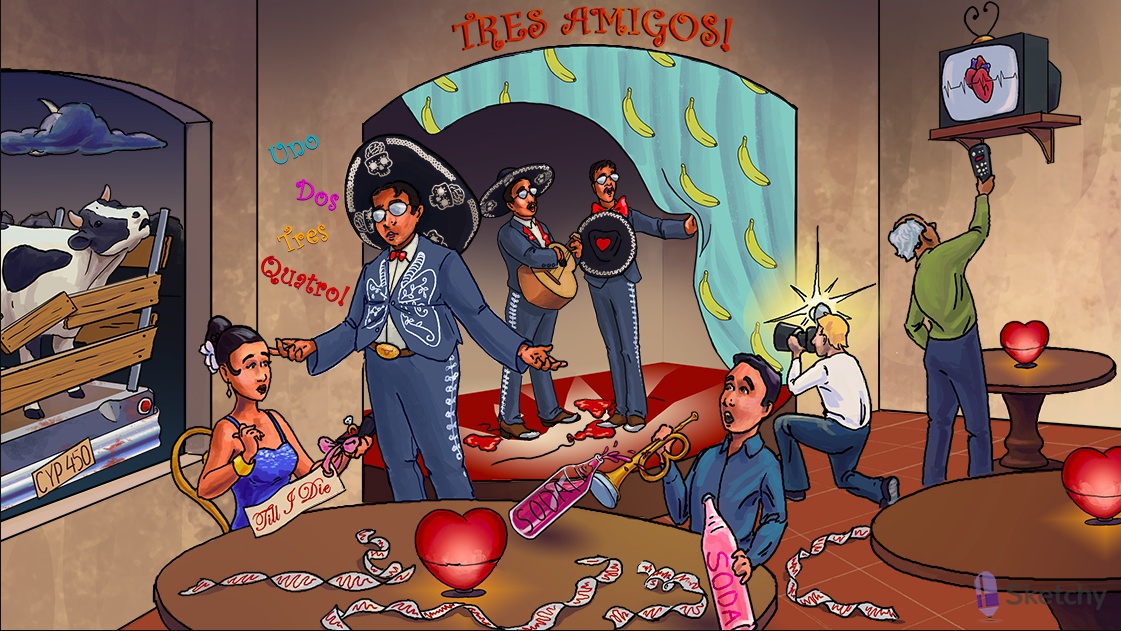
- Trio: class III antiarrhythmics
- Phase 2: plateau dictated by Ca2+
- Phase 3: repolarization dictated by K+
- Potassium banana curtain: K+ current present during phase 2 (plateau) and phase 3 (repolarization) of the caria action potential
- Pushing away the curtain: class III antiarrhythmics block K+ channels prolonging phase 2 and 3 of the cardiac action potential -> prolonged refractory period



- Amigo: amiodarone (class III antiarrhythmic)
- "till I die": -tilide suffix shared by dofetilide and ibutilide (class III antiarrhythmics)
- Soda: sotalol (class III antiarrhythmic)
- Muted bugle: sotalol is also a beta blocker (-lol suffix)

- Amiodarone shares properties of class I, II, III, and IV antiarrhythmics

- Heart illuminated on top and bottom: class III antiarrhythmics treat both supraventricular arrhythmias and ventricular arrhythmias
- Irregularly irregular signal: class III antiarrhythmics treat atrial fibrillation (and flutter)
- Converting the signal: class III antiarrhythmics can restore and maintain normal sinus rhythm in atrial fibrillation and flutter

- Skull brains: amiodarone has many neurologic side effects (e.g.tremor, ataxia, peripheral neuropathy, sleep disturbances)
- Gray sunglasses: amiodarone can cause gray corneal microdeposits
- Big and small bowties: amiodarone can cause hyper or hypothyroidism
- Fibrotic lung embroidery: amiodarone can cause pulmonary fibrosis
- Tight button: amiodarone induced lung fibrosis causes restrictive lung disease
- Hat shielding heart: amiodarone can cause heart block (Class II activity)
- Trampled failing heart balloon: amiodarone can induce heart failure
- Liver spot: amiodarone can cause hypersensitivity hepatitis
- Gray-blue outfits: amiodarone can cause gay-blue skin discoloration
- Flash photo: amiodarone can cause photodermatitis
- Broken chrome bumper: amiodarone inhibits the cytochrome P450 system
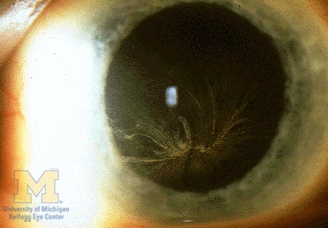
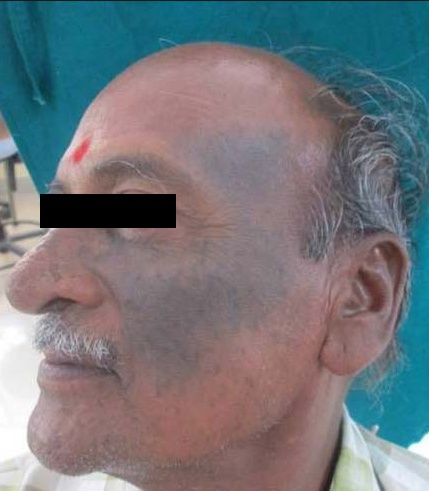

- Twisted streamer: sotalol, dofetilide, and ibutilide can induce torsades (although all type III antiarrhythmics can widen the QT interval)
Class IV
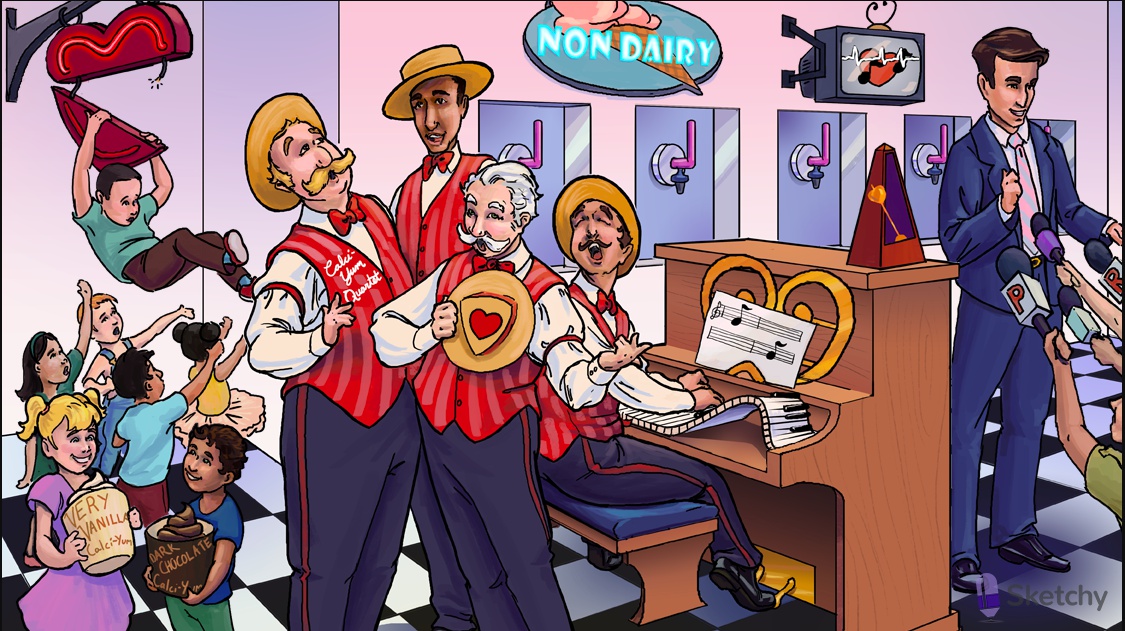
- Quartet: class IV antiarrhythmics
- Nondairy: non-dihydropyridine calcium channel blockers (type IV antiarrhythmics)
- Delicious dark chocolate: diltiazem (non-dihydropyridine CCB)
- Very vanilla: verapamil (non-dihydropyridine CCB)

- block activated and inactivated Ca channels, not resting channels. Work more on tissues fire more frequently and exclusively activated by Ca current
- Notes: non-dihydropyridines (e.g. diltiazem, verapamil) treat arrhythmias by blocking Ca2+ current in the SA and AV nodes
- Disconnected bottom: non-dihydropyridine CCBs decrease atrioventricular conduction
- Phase 4: pacemaker current dictated by Na+ and other ions
- Phase 0: upstroke dictated by Ca2+
- Phase 3: repolarization dictated by K+
- Sliding up the keys: non-dihydropyridine CCBs prolong phase 4 of the nodal action potential -> decreased pacemaker activity, prolonged conduction time and refractory period



- Illuminated top: non-dihydropyridine CCBs treat supraventricular arrhythmias (e.g. atrial fibrillation with RVR)
- Irregularly irregular signal: non-dihydropyridine CCBs are useful in atrial fibrillation (and flutter)
- Metronome: non-dihydropyridines prevent rapid ventricular response in atrial fibrillation and flutter ("rate control")

- Public Relations: non-dihydropyridine CCBs prolong the PR interval on ECG
- Hat shielding heart: non-dihydropyridine CCBs can cause heart block
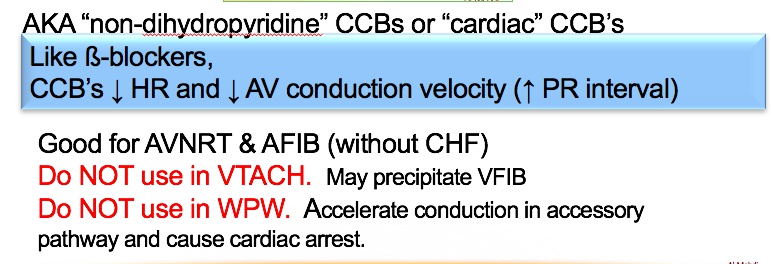

Class V
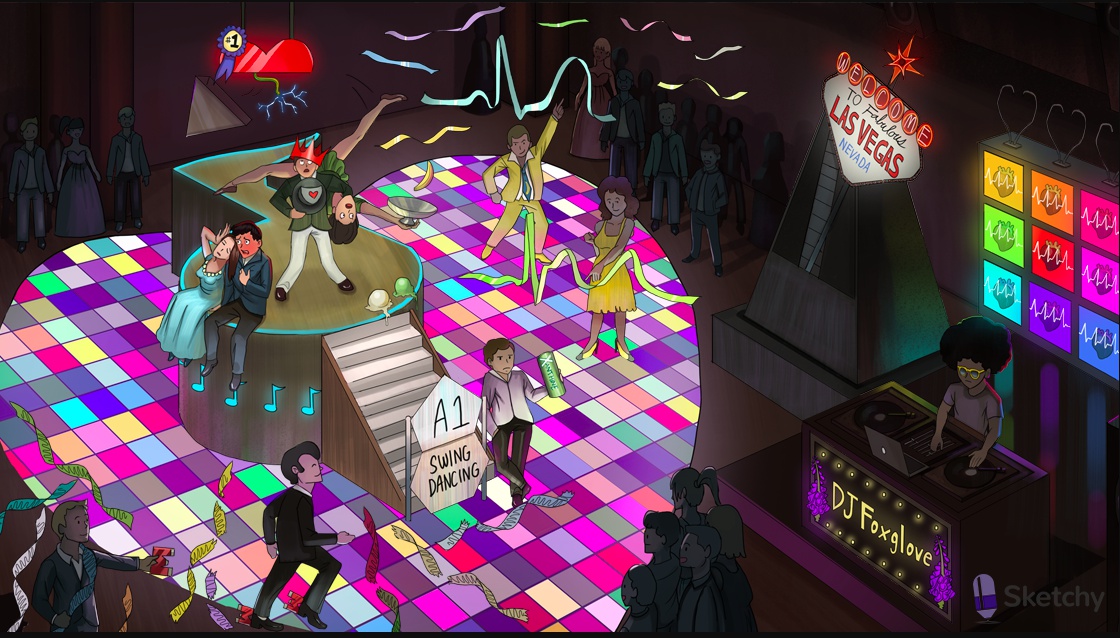
- DJ foxglove: digoxin has antiarrhythmic properties
- Vegas: digoxin exerts direct parasympathomimetic effects via direct stimulation of the vagus nerve -> (more at) AV nodal inhibition
- Irregularly irregular signal: digoxin is useful in atrial fibrillation (and flutter) (1st goal is rate not rhythm)
- Metronome: digoxin prevents rapid ventricular response in atrial fibrillation and flutter ("rate control")


- Magnets: magnesium is useful for the treatment of certain arrhythmias (e.g. torsades)
- Torn twisted torsades streamers: magnesium treats torsades de pointes

- Banana dancer pointing up: hyperkalemia can induce arrhythmias
- Banana dancer pointing down: hypokalemia can induce arrhythmias
- Peaked streamer: hyperkalemia can cause peaked T waves (with shortened QT interval) on ECG
- Streamer with extra bump: hypokalemia can induce U waves at the end of the T wave on ECG
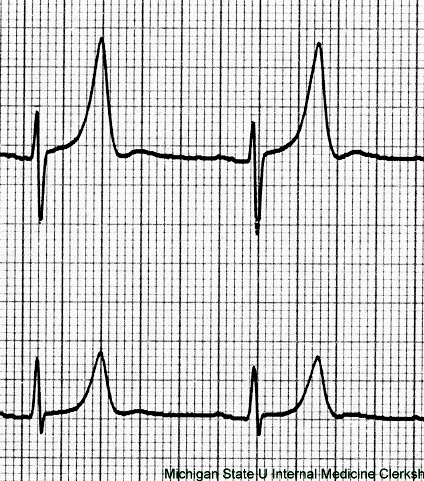
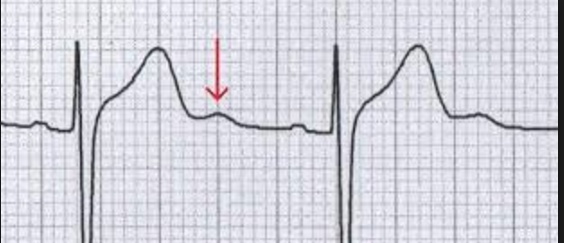

- Swing dancing: adenosine (a purine nucleoside with antiarrhythmic properties)
- Purine shaped gate: adenosine is a purine nucleotide
- A1 Swing: adenosine activates inhibitory A1 receptors on the myocardium and at the SA and AV nodes
- Falling calci-yum ice cream: activation of A1 receptors suppresses inward Ca2+ current (hyperpolarization, suppressed Ca2+ dependent AP
- Banana flying out of cup: activation of A1 receptors increases outward K+ current (hyperpolarization, suppressed Ca2+ dependent AP)


- Note shaped dance floor: adenosine inhibits the AV nodes (decreased AV conduction, prolonged AV refractory period)
- Disconnected bottom of heart: adenosine decreases atrioventricular conduction
- Dilated coronary crown: adenosine causes coronary dilation (mediated by A2 receptors)

- Illuminated #1 top of heart: adenosine is a first line agent for acute treatment of supraventricular arrhythmias (e.g. PSVT)

- Hat blocking heart: adenosine causes transient high grade heart block (direct AV node inhibition) (very quick half life, 10 seconds)
- Flushed dancer: adenosine can cause cutaneous flushing
- Dancer clutching chest: adenosine can cause shortness of breath, chest pain, and an impending sense of doom
- Fainting dancer: adenosine can cause headache and hypotension

- Energy drink blocking A1 gate: the actions of adenosine are inhibited by caffeine and theophylline (methylxanthines)